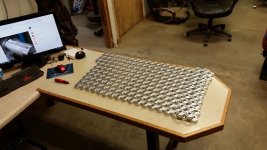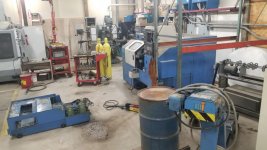You might want to give PETG a try as well. It's a PITA due to stringing and you have to slow down, but it can make some very durable parts. I seem to get more brittleness at higher temps, but it could just be cheap filament.
I had a complex part to make: My dad wanted to put a Fat Boy tank on his Fat Bob, to get 30% more capacity. The instrument panel is different on the tanks, so he cut the sheet metal mount off the bigger tank. I had to design a mount that would adapt the panel to the tank, but it's rather hard to get up inside a cast piece. I took some approximated measurements, modeled it in Fusion 360, then printed a low infill solid model with TPU filament (prints very fast). It took 3 tries, but I got a part that was just the right fit.
I then took that part and a chunk of steel and machined the steel part on the Bridgeport by taking measurements from the 3D printed part with calipers.
This part required 6 sided machining, it was a pyramid shape, had 2 parallel sides and 1 side perpendicular to the parallel side.
I used a sine bar to setup the part for machining the taper. I bolted it down to a fixture to get some of the other features.
I took a bunch of video footage, but ended up just having to get the thing done and didn't film the latter part.
So basically, I took a few caliper measurements, made a 3D model, printed it out, checked it against the parts, revised, checked, revised, checked, had a good exemplar, then made the finished part from steel and welded it to the tank. I made the part 1.5mm shorter than finished height and printed a TPU shim to act as a gasket to prevent vibration and create a resilient surface for the instrument panel to bolt to. The panel normally just crushed the rubber trim gasket that fits against the tank and runs metal to metal. Knowing Harley's propensity for vibration, I thought a gasket made of a squishy material would be ideal to help prevent any vibration (which would lead to fatigue and cracking of the welds).
FWIW, Harley used 1/4-20 stainless button head bolts to attach the IP to the tank, with some panel nuts that pop into the backside of the sheet metal mount. I was surprised they were not metric.
The IP is a cast zinc piece and it's VERY clear that they took full advantage of 3D CAD to design the mold and clearances. Those little sheet metal carriers that hold panel nuts, they actually made reliefs in the mold to clear those little fingers, that's how tight the fitup is on that part.






![20200104_191546[1].jpg 20200104_191546[1].jpg](https://www.practicalmachinist.com/forum/data/attachments/231/231403-b22818730d8c266adfbeee61426bd590.jpg)